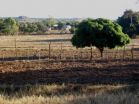(Press-News.org) URBANA, Ill. - Crop yields in the fragile semi-arid areas of Zimbabwe have been declining over time due to a decline in soil fertility resulting from mono-cropping, lack of fertilizer, and other factors. In collaboration with the International Crops Research Institute for the Semi-Arid Tropics (ICRISAT), University of Illinois researchers evaluated the use of a precision farming technique called "microdosing," its effect on food security, and its ability to improve yield at a low cost to farmers.
"Microdosing involves applying a small, affordable amount of fertilizer with the seed at planting time or as top dressing three to four weeks after emergence," explained U of I agricultural economist Alex Winter-Nelson. "So, instead of spreading fertilizer over the entire field, microdosing uses fertilizer more efficiently and ultimately improves productivity. Our research shows that smallholder farmers' investment in microdosing has really unlocked the power of chemical fertilizers in some of the low-rainfall areas of Zimbabwe."
Training is the key to adoption of the technique. "About 75 percent of households receiving microdosing training used fertilizer in 2011," said Winter-Nelson. "This compares to less than 25 percent of households that had not received training. Another way of looking at it is that training in microdosing raised the probability of adoption by 30 to 35 percentage points. Knowledge of microdosing changed people's attitudes about fertilizer. Those who had training generally disagreed with the common notion that fertilizer is not worth its price or that it burns crops."
Winter-Nelson said that there are some hurdles to overcome, however. "Sustaining and expanding the benefits of microdosing technology will require efforts to ensure that private agrodealers are able to stock the product in a timely manner and to package it in a manner that smallholder farmers find useful," he said. "This is complicated by the financial capacities of agrodealers and by difficulty in projecting fertilizer demand, which varies with rainfall.
"We also need to work on extending training to underserved areas and to train extension personnel in low-rainfall areas," he said. "Female-headed households were significantly less likely to adopt microdosing than others, possibly reflecting labor shortages or difficulties accessing fertilizer. Understanding the particular constraints that female farmers face and adapting the methods or the training to their circumstances could also help extend adoption of the technique."
The research data were collected via a structured household survey in eight districts in semi-arid areas with additional information about fertilizer availability and demand from key informant interviews with local extension service providers, non-governmental organizations, and agrodealers. Focus group discussions were also utilized. The household survey included questions about assets, cropping patterns, agricultural production, training in microdosing, extension techniques, and fertilizer use and adoption, with particular attention paid to management practices and output on cereal plots two previous cropping seasons.
"What was particularly encouraging from the data is that, when comparing the costs of research, development, and promotion of microdosing in Zimbabwe to the gains achieved through a 30 percent adoption rate and an estimated productivity effect, the data suggest an internal rate of return on the investment in microdosing of over 40 percent," Winter-Nelson said. "And that's a good motivation to continue to try to get more farmers in Zimbabwe to try microdosing."
INFORMATION:
"Impact of Fertilizer Microdosing Research and Development in Semi-arid Zimbabwe" was produced for the International Crops Research Institute for the Semi-Arid Tropics. Other contributors to the report are Jayne L. Stack, Tarisayi Pedzisa, and Brighton M. Mvumi from the University of Zimbabwe.
Fertilizer in small doses yields higher returns for less money
2014-03-06
ELSE PRESS RELEASES FROM THIS DATE:
Story Tips from the Department of Energy's Oak Ridge National Laboratory, March 2014
2014-03-06
MATERIALS – Lighter, stronger engines . . .
Engines could become lighter and more efficient because of a research project that combines the talents and resources of the Chrysler Group, Nemak S.A. of Mexico and Oak Ridge National Laboratory. The goal of the four-year $5.5 million cooperative research and development agreement is to develop an advanced cast aluminum alloy for next-generation higher efficiency engines. In addition to being lighter, the new alloy for cylinder heads would be stronger and capable of sustaining the higher temperatures and pressures of engines ...
Preschoolers can outsmart college students at figuring out gizmos
2014-03-06
Preschoolers can be smarter than college students at figuring out how unusual toys and gadgets work because they're more flexible and less biased than adults in their ideas about cause and effect, according to new research from the University of California, Berkeley, and the University of Edinburgh.
The findings suggest that technology and innovation can benefit from the exploratory learning and probabilistic reasoning skills that come naturally to young children, many of whom are learning to use smartphones even before they can tie their shoelaces. The findings also ...
Kawasaki disease and pregnant women
2014-03-06
In the first study of its type, researchers at the University of California, San Diego School of Medicine have looked at the health threat to pregnant women with a history of Kawasaki disease (KD), concluding that the risks are low with informed management and care.
The findings are published in the March 6, 2014 online edition of the British Journal of Obstetrics and Gynaecology.
KD is a childhood condition affecting the coronary arteries. It is the most common cause of acquired heart disease in children. First recognized in Japan following World War II, KD diagnoses ...
Early detection helps manage a chronic graft-vs.-host disease complication
2014-03-06
SEATTLE – A simple questionnaire that rates breathing difficulties on a scale of 0 to 3 predicts survival in chronic graft-vs.-host disease, according to a study published in the March issue of Biology of Blood and Marrow Transplantation.
And although a poor score means a higher risk of death, asking a simple question that can spot lung involvement early means that patients can begin treatments to reduce or manage symptoms, said senior author Stephanie Lee, M.D., M.P.H., research director of Fred Hutchinson Cancer Research Center's Long-Term Follow-Up Program, member ...
Crashing comets explain surprise gas clump around young star
2014-03-06
Beta Pictoris, a nearby star easily visible to the naked eye in the southern sky, is already hailed as the archetypal young planetary system. It is known to harbour a planet that orbits some 1.2 billion kilometres from the star, and it was one of the first stars found to be surrounded by a large disc of dusty debris [1].
New observations from ALMA now show that the disc is permeated by carbon monoxide gas.
Paradoxically the presence of carbon monoxide, which is so harmful to humans on Earth, could indicate that the Beta Pictoris planetary system may eventually become ...
ALMA sees icy wreckage in nearby solar system
2014-03-06
Astronomers using the Atacama Large Millimeter/submillimeter Array (ALMA) telescope have discovered the splattered remains of comets colliding together around a nearby star; the researchers believe they are witnessing the total destruction of one of these icy bodies once every five minutes.
The "smoking gun" implicating this frosty demolition is the detection of a surprisingly compact region of carbon monoxide (CO) gas swirling around the young, nearby star Beta Pictoris.
"Molecules of CO can survive around a star for only a brief time, about 100 years, before being ...
Galactic gas caused by colliding comets suggests mystery 'shepherd' exoplanet
2014-03-06
Astronomers exploring the disk of debris around the young star Beta Pictoris have discovered a compact cloud of carbon monoxide located about 8 billion miles (13 billion kilometers) from the star. This concentration of poisonous gas – usually destroyed by starlight – is being constantly replenished by ongoing rapid-fire collisions among a swarm of icy, comet-like bodies.
In fact, to offset the destruction of carbon monoxide (CO) molecules around the star, a large comet must be getting completely destroyed every five minutes, say researchers.
They suggest the comet swarm ...
Vitamin D increases breast cancer patient survival
2014-03-06
Breast cancer patients with high levels of vitamin D in their blood are twice as likely to survive the disease as women with low levels of this nutrient, report University of California, San Diego School of Medicine researchers in the March issue of Anticancer Research.
In previous studies, Cedric F. Garland, DrPH, professor in the Department of Family and Preventive Medicine, showed that low vitamin D levels were linked to a high risk of premenopausal breast cancer. That finding, he said, prompted him to question the relationship between 25-hydroxyvitamin D — a metabolite ...
UT Arlington study links BPA and breast cancer tumor growth
2014-03-06
UT Arlington biochemists say their newly published study brings researchers a step closer to understanding how the commonly used synthetic compound bisphenol-A, or BPA, may promote breast cancer growth.
Subhrangsu Mandal, associate professor of chemistry/biochemistry, and Arunoday Bhan, a PhD student in Mandal's lab, looked at a molecule called RNA HOTAIR. HOTAIR is an abbreviation for long, non-coding RNA, a part of DNA in humans and other vertebrates. HOTAIR does not produce a protein on its own but, when it is being expressed or functioning, it can suppress genes that ...
NASA's TRMM satellite images show California soaker moved eastward
2014-03-06
The Tropical Rainfall Measuring Mission or TRMM satellite provided a look at the rainfall associated with the large storm system that brought soaking rains to California on Feb. 28 and Mar. 1. Satellite imagery created at NASA shows the movement of the storm from the U.S. West Coast to the East Coast.
At NASA's Goddard Space Flight Center in Greenbelt, Md. images were created using data from the TRMM Microwave Imager (TMI) instrument that showed the movement of recent stormy weather from California's Pacific Ocean coast to the Atlantic Coast. TRMM is a satellite managed ...






